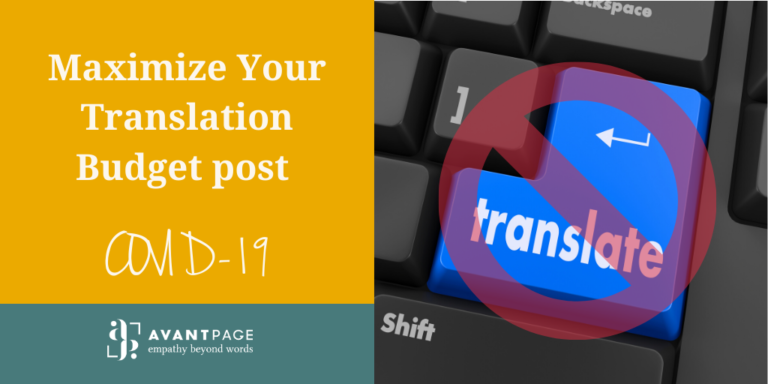Blogs

How to Promote COVID-19 Vaccination in LEP Communities
With the COVID-19 vaccine rollout underway, the end of the pandemic may soon be in sight. Yet healthcare professionals still face the daunting task of vaccinating millions of residents in the coming months. Vaccine distribution, misinformation, and a lack of language support for limited English proficient (LEP) populations all pose major challenges to their success. Fortunately, with the proper planning, healthcare organizations can better serve LEP members using a combination of multilingual outreach and language services. In this article, we’ll offer guidance on the ways in which you can improve vaccination rates and member care in these communities. Given the diversity within the LEP population, a one-size-fits-all approach is probably not your best bet. Views on vaccines, healthcare, and the medical establishment vary among cultures. For example, a Langer Research study found that only 34% of Latinos trust that the vaccine is safe—despite being a high-risk group. Before you launch a campaign that targets a specific community, you need to develop messaging that will resonate with them. That may mean addressing fears about safety, misinformation about side effects, and other misconceptions about healthcare in general. Next, you need to decide which materials need to be translated. We recommend translating digital outreach such as: We also recommend translating any direct mail or member information you plan to send. Mailers not only give recipients something tangible, but they’re also more accessible. Not everyone uses social media or has internet access. Outreach in multiple languages is a great first step, but LEP speakers also need language support before, during, and sometimes after a vaccine appointment. Yet a study conducted at Seattle Children’s Hospital found that only 45.4% of families who preferred a non-English language used an interpreter during a visit. And interpretation services were even less common during busier times of the day. This underutilization often leaves members struggling to communicate with providers and unable to understand procedures, recommendations, and treatment options. Due to the risks of COVID-19, bringing a medical interpreter onsite may not be a viable option. However, over-the-phone interpreting (OPI) and video remote interpreting (VRI) make it easy to connect with one remotely. The method you choose will depend on the circumstances. OPI works well when members: VRI works well during: Translated member information leaflets from the pharmaceutical company, fact sheets, and other member-facing materials are also useful. These help members understand what to expect and provide guidance on which side effects may require follow up care. As you can see, removing language barriers requires a combination of culturally-appropriate translation and interpreting services. That’s why you need a language services company that knows how to serve LEP communities. At Avantpage, we work with healthcare providers, government organizations, life sciences companies, and health insurance carriers to provide LEP speakers with the language support they need. Ready to start your next translation project? Contact us today to find out how we can help!

How to Provide Digital-First Multicultural Healthcare
From researching doctors and hospitals to booking appointments, more people than ever are starting their healthcare journey online. The need for digital resources doesn’t stop there, either. Existing patients benefit from provider websites with patient portals, which offer access to health records, test results, and more. Yet language barriers make it difficult for patients with limited English proficiency (LEP) to access these resources. However, healthcare organizations can ensure multilingual patients receive the support they need through a combination of website localization, translation, remote and interpreting. Given their diverse backgrounds, LEP speakers have differing views about healthcare. Simply translating web content into another language may fail to take this into account. That’s why we recommend a process known as website localization, which involves adapting cultural elements in addition to translation. Localization may include: A linguistically and culturally-relevant website not only gives LEP speakers access to online resources, but can also help build trust between patients and their providers. While translation is an essential part of website localization, other patient materials—both online and off—may need to be translated as well. Office signs, patient forms, and treatment instructions are just a few materials you may want to provide in multiple languages. This makes it easier for LEP patients to navigate the healthcare system and participate in their own care. Although the accuracy of machine translation has improved in recent years, human translators are still better at providing accurate, culturally-relevant translations that meet regulations. A language service provider (LSP) that specializes in healthcare can ensure that all of your translations meet those requirements. LEP patients often experience poorer health outcomes due, in part, to poor patient-provider communication. Language barriers make it difficult for patients to express their needs and understand treatment recommendations. While bilingual staff and onsite medical interpreters typically bridge this gap, they may not always be available. Fortunately, remote interpreting options make it possible to connect with a medical interpreter at any time. There are two types of remote interpreting: video remote interpreting (VRI) and over-the-phone interpreting (OPI). Each has its benefits. VRI works well for: OPI works well for: Most LSPs offer remote interpreting services and can even advise you on which method will best meet your needs. As you can see, website localization, translation, and interpreting work together to provide LEP patients with the resources and support they need. While this process may sound complex, an LSP that specializes in healthcare can help you develop experiences that let patients move seamlessly through the healthcare journey. By partnering with Avantpage, you’ll benefit from our expertise in healthcare—as well as our localization, translation, and interpreting services. We specialize in working with organizations that serve LEP communities, and know how to help you address their unique needs. Ready to discuss your multilingual project? Contact us today. Want to learn more about how localization, translation, and remote interpreting can improve multicultural patient care? Download our white paper Digital-First Multicultural Healthcare: Improving Language Access Through Localization, Translation, and Interpreting.

Why Humans Medical Translators Still Matter
Machine translation offers a fast, affordable way to translate web content. In fact, Google Translate provides instantaneous translations in over 100 languages—for free. Yet before you copy and paste your medical content, we recommend weighing the pros and cons of forgoing the services of a professional translator. In this article, we’ll explore the differences between the two methods, and help you decide which is right for your project. Machine translation, not to be confused with Computer-assisted translation (CAT), is a method of automated translation. Artificial intelligence software that has been trained to understand natural languages can translate one language into another. It’s faster, more affordable, and easier to scale than human translation. Yet it still has a lower rate of accuracy and lacks one essential skill: the ability to determine context. Machine Translation works best for projects that: Human medical translators, on the other hand, have an in-depth knowledge of the nuances and cultural differences between the languages they translate. However, human translation is costlier and takes longer. Although translators use CAT tools to help them work faster, they can’t compete with machines in that arena. Given that they require a higher degree of accuracy, human translation is typically best. While machine translation can produce grammatically correct content, it can’t take into account how a reader will interpret it. Here’s an example. A Google generated Spanish translation of the Virginia Department of Health’s website told visitors that the Coronavirus vaccine “no es necesario”, or is not necessary. The health department wanted to make it clear that the vaccine isn’t mandatory. Yet visitors could misinterpret it to mean that Latinos don’t need the vaccine, despite being part of a high-risk group. Whether you have a need for scalability or lack the budget, machine translation combined with human post-editing can serve as an alternative to human translation. Some languages services companies provide post-editing services that will ensure your translation is linguistically accurate and culturally appropriate. Internal bilingual staff can also perform the task. Here’s how:

Tips for translating into uncommon languages
Working with uncommon languages can present various challenges. Here are our tips for success in your rare language translation project: Some languages have dialect variations among regions or communities, there can be different names for the same language, and there can be different languages with the same name. Some languages also use various writing systems or have no official standards for their written version. Therefore, confirm that you have selected the accurate language. The Avantpage team can help you if you are unsure. Remember, the target community for rare languages tends to be small, and confusion could lead to choosing an incorrect language. For example: Once you have the accurate language, find out everything you can about it. Make sure you know what the language looks like (using Google or Omniglot), if it runs right-to-left, if the characters require a particular font, and any other relevant characteristics of the target community. With this information, you can categorize your language: Before we proceed with the project, our project manager (PM) will work on confirming linguists’ availability and giving you the best possible turn-around-time (TAT) Note that resources for rare languages are sometimes limited, and linguists might not work with our usual computer assisted translation (CAT) tools. This might mean that some additional time may be required for the translation to be ready. If no resources are available, our PM will unfortunately have to decline the project. Projects with rare languages will likely need more supervision from our PM. Here is a sneak peek at what’s going on from the Avantpage side:

"Language" according to linguist and former missionary, Daniel Everett
As we keep on working from home and searching for new sources of inspiration, we at Avantpage have continued our Book Club initiative. Our second pick was Don’t Sleep, There Are Snakes: Life and Language in the Amazonian Jungle, by linguist and former missionary Daniel Everett. In the book, Everett recounts his astonishing experiences with the Pirahã people, an indigenous Amazonian tribe in Brazil whom he lived with in the 70s. Everett arrived on the banks of the Maici River in 1977, accompanied by his wife and their three small children. This American, Christian family ended up living among the Pirahãs intermittently for seven years, over a period of three decades. Their mission was funded by the Summer Institute of Linguistics, a Christian nonprofit whose evangelizing method is to translate the Bible into the target community’s language. In order to translate the Bible, Everett had the near-impossible quest to learn Pirahã in order to understand their grammar. During this mission, Everett ended up questioning his own culture, customs, values, and faith, besides discovering some fascinating characteristics of this rare and puzzling language. Everett grasps the readers’ attention from the start with some nerve-wracking anecdotes that include a life-or-death encounter with an anaconda, malaria that almost killed his wife and daughter, and several risky misunderstandings with the Pirahãs themselves. He also notes that, as a linguist, his initial discoveries baffled him: Pirahã language seemed to have no words for colors, no numbers, quantifiers or counting in any form, no past tenses, no comparatives, no recursion... Besides, Pirahã has one of the smallest sets of speech sounds or phonemes in the world: three vowels and just eight consonants for men (seven for women). (If you’re interested in listening to how this language sounds, check out this intriguing recording). After much research, Everett comes to question Noam Chomsky’s broadly accepted theories about grammar through bold claims in the field of linguistics, all based in the Pirahã tongue. Apart from their language, the Pirahãs also have ways of thinking, planning, and acting that seem far from Everett’s strict Christian, Western ways. As the author reflects, “language is the product of synergism between values of a society, communication theory, biology, physiology, physics (of the inherent limitations of our brains as well as our phonetics), and human thought”. This view of language is shown in the book through the links that Everett finds between Pirahã language and culture. This linguist dedicated several years of his life to understanding the Pirahã people, and his accounts make a fascinating read. During our book club meetings, we agreed that perhaps Everett’s writing isn’t the best, but his stories are so captivating that they make the book highly enjoyable. It’s also worth mentioning that this book has produced some controversy, especially among academics, due to its linguistic claims. Still, Everett’s unique anecdotes and theories make his claims worth exploring further. And even if you’re not a linguist, why not travel to the Amazon and find out how the Pirahãs experience the world?

Making cinematic experience accessible
The fact that translation accompanies us in each aspect of our everyday life is undeniable. Very often, we do not even pay attention to its existence. However, there is a specific field of interpreting which has flourished with the technological expansion over the years: Audiovisual Translation (AVT). It is all about making the cinematic experience accessible and entertaining. It is said that the cinema was born with the first movie of the Lumière brothers at the end of the 19th century. At the time, it was impossible to record sound, therefore, the creators were using boards to provide the background for the onscreen action. In a sense, those were the first subtitles available to the movie connoisseurs. In the 1930s, when the cinematic expansion sailed overseas, Paramount Pictures decided to take movie translation to the next level. They opened a studio near Paris and recreated the stage designs of American blockbusters. The screenplays were translated into numerous European languages, and the actors from each country were hired to shoot the movies. Unfortunately, as the idea was too expensive and the European audience was not interested in the American format, Paramount focused on producing movies back in the United States. Thankfully, over the years, many types of communication channels were developed which gave us the opportunity to enjoy audiovisual masterpieces from all over the world. The most popular forms of AVT are subtitles, dubbing, and voiceover (extremely popular in Eastern Europe). However, we need to look beyond meaning. It is important to understand that Audiovisual Translation allowed people with disabilities to receive a movie without any content loss with the advance of audio-description and subtitles for Deaf and Hard of Hearing communities. In the process of Audiovisual Translation, interpreters face numerous difficulties. There is the issue of cultural background which strongly influences translation. Localization is one of the hardest challenges, but if we look at it from another perspective, it gives the linguist the opportunity to let imagination run wild and be creative. AVT does not need to be precise. If the main idea and the mood of the conversation are captured, translation may be considered as a successful one. But after all, it is always up to the audience to determine that, isn't it?

Multicultural Health Insurance Marketing During COVID-19
As the 2020 Open Enrollment Period nears, the effects of COVID-19 still loom large over the health insurance market. An estimated 5.4 million Americans became uninsured due to job loss from February to May, making this one of the largest drops in coverage in years. Of those losses, 46% occurred in just five states. Residents of California, Texas, Florida, New York, and North Carolina were the hardest hit—all of which have large populations of racial and ethnic minorities. While “we’re all in this together” is a popular refrain, the pandemic and its effects (such as hospitalizations and job losses) have disproportionately impacted minorities. That means your multicultural marketing strategy must also address these challenges to get people from those communities to enroll in health insurance coverage. Simply updating last year’s marketing materials won’t help you connect with minorities who need to know you understand their unique needs. That’s why we’ve come up with some key messages you’ll want to include in your multicultural health insurance marketing campaigns. African Americans and Latinos are significantly more likely to be hospitalized and/or die from COVID-19. This is due, in part, because they not only make up a higher percentage of essential workers but also have higher rates of chronic diseases such as diabetes and high blood pressure. Although there’s no need to be alarmist, it is important to highlight the benefits of preventive care and chronic disease management. By keeping conditions such as high blood pressure and diabetes under control, African Americans and Latinos can improve their health outcomes. You’ll want to emphasize why this type of care is essential, and how qualified health plans make it more affordable. Economic pain due to COVID-19 restrictions is widespread, but Latinos have been hit the hardest. Nearly half (49%) of Latinos reported that they or someone in their household has taken a pay cut, lost a job, or both compared to 33% of all U.S. adults. Loss of employment along employer-sponsored health insurance leaves more Latinos without coverage and the income to pay for it. As you develop your marketing strategy, highlight the affordability of your health plans along with information about receiving financial assistance. Also, make it clear that lawfully present immigrants are eligible—you don’t need to be a U.S. citizen to qualify. Telehealth is often a major selling point for health plans. It offers a convenient way to access basic and routine care—without a visit to the doctor’s office. This benefit has been especially important during COVID-19, as some patients may have been unable to receive care otherwise. While telehealth has its advantages, it’s not always accessible for patients with limited English skills. Language barriers make it difficult for limited English proficiency (LEP) patients to communicate, which often deters them from seeking care. For example, when a University of California at San Francisco primary clinic switched to telehealth, the percentage of visits from non-English speaking patients dropped from 14% to 7%. This shift toward telehealth poses a major challenge when it comes to providing care for the 25 million LEP speakers who live in the U.S. According to data from the U.S. Census Bureau: That doesn’t mean you need to remove all references to telehealth from your multilingual messaging though. Patients can still use telehealth with the help of an interpreter, but they need to know this is an option. Including information about how doctors can connect patients with a medical interpreter will help you promote this option to potential LEP plan beneficiaries. Creating culturally-relevant marketing campaigns in multiple languages is a major undertaking, especially when it’s for a highly regulated field such as health insurance. Fortunately, Avantpage is here to help. With over 20 years of translation experience in the field, we know how to adapt your health insurance messaging. From health plan translations to Medicare marketing, we have you covered. All of our translators must pass tests built on ISO 17100 standards in addition to meeting our requirements for qualifications and credentials. This ensures that you’ll always receive the highest quality health insurance-related translations. Ready to discuss your language needs? Contact us today to request a free quote!

Best Practices for Multilingual Websites
Why the Government Community Should Follow Digital.gov’s Best Practices for Multilingual Websites Thank you, Laura Godfrey, Fedora Braverman, Lina Younes, and Leilani Martinez for your great inputs and for allowing Avantpage to share this information with our clients and partners. Digital.gov is a cross-functional team of writers, editors, strategists, technologists, and designers who all work at the Technology Transformation Services (TTS) at the General Services Administration (GSA). Their mission is to help the government community deliver better digital services by providing professionals in the federal government with the tools, methods, practices, and policy guidance they need to deliver effective and accessible digital services. At Avantpage, we help our clients create a linguistic bridge that connects people, cultures, and communities through mutual understanding. We are committed to providing exceptional translation, localization and interpretation services in more than 150 languages to clients primarily in the government, election and education sectors, among many others. With over 25 years of tenure in the field of language services and the digitalization of information, we are proud to endorse the recommendations from the team at Digital.gov: Avantpage has a team of localization experts, both on the translation and digital content publishing for Multilingual Websites. To find out more about how we can streamline your next localization project, call us at 530-750-2040, or request a free quote today.

How the California Lawyers Association changed its role during COVID-19 pandemic
Established in 2018, the California Lawyers Association (CLA) is a nonprofit, voluntary organization, and the new home of the Sections of the State Bar of California and the California Young Lawyers Association. Its membership represents the vast diversity of California’s legal community and the various areas of law practiced throughout the state. CLA delivers high-quality programs, events, and resources and continuously seeks new ways to expand its offerings to fostering excellence and fellowship throughout the California legal community. CLA’s typical audience could be a small business owner, an hourly employee, a landlord, or any other individual in the State of California who does not practice law and could benefit from legal guidance. We recently had the pleasure of discussing CLA’s role during the pandemic with Ellen Miller, Director of Strategic Partnerships and Initiatives and Lauren Elledge, Initiatives Coordinator. When the State of California issued Shelter in Place orders, Ellen’s team worked on an initiative dedicated to providing guidance to employees, employers, families, and businesses in an effective and innovative way. Find out how CLA addressed many legal questions that came up during the pandemic. “NAVIGATING COVID-19 ISSUES” In response to COVID-19, CLA shifted its focus to create a dedicated channel that provides civic, community, and business resources such as information about the Cares Act, the Disaster Legal Assistance Collaborative, the Impact on Statewide Evictions, and a series of videos on how to best navigate issues surrounding the pandemic. CLA uses YouTube as a platform to share basic information on the various legal issues that have come up as a result of the COVID-19 pandemic. These videos have been made available with closed captions in English and/or Spanish. Some videos are presented by a Spanish-speaking attorney or have been translated into Spanish. COVID-19 ACCELERATED CLA’S LEGAL TRANSLATION PLAN Before the COVID-19 pandemic, CLA had limited experience with translating for Limited English Speakers. Spanish is the first language chosen, thanks to the voluntary work of many members as well as CLA’s relationship with a school that teaches student interpreters. Because of the pandemic, CLA accelerated its plan to provide its members with basic information on various legal issues. With a larger scope in mind, CLA contacted Avantpage to discuss additional collaboration on the translated content. Having access to both partners ensures that the project can continue to move forward. WHY AVANTPAGE? CLA’s mission is to promote excellence, diversity, and inclusion in the legal profession, fairness in the administration of justice and rule of law. When local counties and the State of California issued Shelter in Place orders, CLA knew it had an opportunity to share its resources with bar associations, other trade, and professional associations, legal services providers, and more. Collaborating with a Language Service Provider such as Avantpage presented an opportunity to expand that reach even further. COVID-19 IMPACT ON CLA’S OUTREACH PLANS CLA is relatively new to publishing video content and has not yet captured the performance of its English or Spanish-language videos. While they don’t anticipate the videos going viral, Ellen Miller explains that “any views of the videos feel like a success in the interest of closing the justice gap.” CLA’s office of initiatives is working towards creating various projects, and more videos will be produced, translated, and localized for the benefits of all citizens of California including LEP communities. There is great potential for other key players in the legal industry to use language access to better serve their LEP clients and populations. Avantpage’s qualified, subject matter expert translators can meet all of your legal translation needs. Find out how. Call us at 530-750-2040 or request a free quote to get started with your project today.

Maximize Your Translation Budget post COVID-19
COVID-19 continues to impact communities across the world. Both private and public sectors are forced to make significant budget revisions in response to recent drops in revenue and the changing needs of the people they serve. Having a limited budget doesn’t mean you can’t communicate effectively with immigrant and LEP communities. Many organizations may be tempted to turn to machine translation due to budget cuts, which may compromise the quality of their translation projects. In our blog dated Jan 9, 2020, we highlighted “The Many Ways Human Translation Benefits Your Organization”. Through our research, we came across with a study “Analysis of human versus machine translation accuracy” completed by Montana Technological University, Butte (Montana Tech) After many procedures and analysis, Montana Tech concluded: “Machine Translation (MT) is a fast way to obtain a domain-specific translation but is not recommended for literary translation… Based on the results of this study it is clear that human translators, with at least a moderate exposure to a non-native language, are more accurate than translation carried out using freely available MT tools… In the long run, mistranslation produced by machines could continue to be culturally offensive; cause harm in high-risk situations; and negatively affect a company’s brand, reputation, and revenues. The results of this research strongly indicate that international companies should adopt human translation resources as opposed to relying on cheaper, but considerably less effective and less accurate MT. Additionally, it is recommended that companies employ team translation where more than one person is involved in the translation process, which would further increase the accuracy of translation as a result of involving multiple individuals with variable interpretations of linguistic connotation and cultural meaning.” What are the alternatives? Whether you’re working on a large or small project, know your milestones and deadlines. Leverage translation best practices with your LSP. Identify your needs and define your scope Knowing your immediate and future language needs helps your LSP to make necessary accommodations and facilitates planning. It’s of benefit to your organization and your project to determine which content will best reach your target audience. If you don’t know where to start, you can work with your Language Service Provider to help make that determination. Gather your brand assets for design purposes Before starting your project, gather your logo, stock photos, downloads, and any other content that you’ll want to be used for the project. If you have the native, editable files (from InDesign, Photoshop, Illustrator, etc.), those are among the most useful assets to give to your LSP. Make use of linguistic assets Translation Memory reuses past translations to increase translation efficiency. When your translation project is completed, the language from the original (or source) document is stored along with the language from its translated counterpart in a secure database. This occurs with every project as you begin to build a translation memory. Glossaries, another linguistic asset, include a set of key terms and their approved translations. They’re particularly useful for indicating approved translations of industry-specific terms, and terms you want consistently translated across your documents. Style guides, the third of these vital tools, inform your LSP and translators about your organization’s look, voice, and general identity. This is also a great place to address practical questions for your translators, such as how to handle translating acronyms and what words should be left in English. Translation style guides and glossaries are some of the most critical components of your project. They will positively help to increase the consistency of your translated terms across all your material. Keep open communication with your LSP Your needs may change over time: you may need your LSP to add their Desktop Publishing process, a new language, or even a new language service. Be sure to communicate your plans, initiatives, and vision effectively to your LSP. At Avantpage, we create a culture of warmth, belonging, and approach every partnership with Empathy Beyond Words. Working on your translation projects during and after a pandemic such as COVID-19 needn’t be stressful. Thousands of customers trust us for our language services expertise combined with decades of experience. We have the courage to shape a better future for you and the immigrant communities you serve. Call us at 530-750-2040 or request a free quote today.
How COVID-19 shapes the Election
Exercising our civic duty to vote could become challenging during the COVID-19 pandemic. What can we expect for the next election? While there is uncertainty around how states will prepare for it, a move towards increased vote-by-mail seems inevitable. Western states’ residents have long participated in their elections from afar. Before COVID-19 pandemic Washington, Oregon, Utah, Colorado already led in vote-by-mail. States that already mastered massive vote-by-mail systems are serving as informal information clearinghouses for others, dispensing advice on everything from how to line up the best vendors for printing and distributing paper ballots to setting up drive-by or other drop-off points for voters. However, for states that don’t have a history of vote-by-mail, it's not an easy endeavor. The logistics of transitioning to vote-by-mail is a big undertaking and they have to take into consideration everyone, including their Limited English Proficient (LEP) communities. On May 8, California Governor Gavin Newsom announced that his state will mail a ballot to all registered voters for the November general election. This is a significant decision as California and many states seek to protect both voting rights and public health during the COVID-19 pandemic. As mentioned above, Colorado, Hawaii, Oregon, Washington, and Utah already mail out ballots to all registered voters. For all other states that have not taken this initiative, registered voters must apply to vote by mail. The CARES Act, passed in late March, included $400 million to help states run elections during the pandemic, but some states have raised concerns that they may not be able to access the funds because of restrictions. To address the restriction concerns, $4 billion has been identified to be set aside for voting by mail upon approval by lawmakers as the fourth COVID-19 stimulus package. Funding is not the only challenge. In New York City, the Board of Elections will begin mailing 3.6 million absentee ballot applications to voters, but with the national envelope shortage and requirement to provide prepaid postage so voters can return their ballot for free, there are real challenges for everyone. Additionally, there are myriad additional risks and hazards that could affect the elections such as power outages, wildfires, cyber-attacks, and even regular influenza that may occur at the same time. While it is difficult to predict, there are legitimate feelings of fear and risks that there won’t be enough resources to care for all aspects concerning LEP communities. Translating outreach materials into all languages won’t be feasible. State and County officials will have to focus on the highest demand - from one county to another, the needs in translation could look very different. Unfortunately, some languages won’t make the cut as officials will have to prioritize due to their tight budgets. What will happen to poll workers (bilingual or other)? Even with increased vote-by-mail options, it is likely that many states will see some kind of in-person voting. Poll workers are essential, but are they putting themselves at risk? And in the lead up to the election, what will happen to their scheduled in-person training? In the event that a poll worker becomes ill due to the COVID-19 virus during training, for example, the entire team may have to be quarantined, leaving a staffing shortage. Poll worker understanding of language access rights on Election Day is essential, and this topic is just one part of the critical in-person training that counties carry out each cycle. There are concerns that online training may not be sufficient as a substitution. For states and counties where vote-by-mail ballot use is already high, the financial impact will be less significant than for those with low historical vote-by-mail numbers. Montana for example, with 63% historical vote-by-mail, will not see costs as high as North Dakota, where only 29% of voters voted by mail in 2018. Another consideration is the use of facsimile ballots in polling stations. We talked to one of our CA county partners, who laminates facsimile (sample) ballots for voters to take to the booth for comparison. While this solution may work for in-person voting, to provide this for an absentee ballot would mean printing and mailing the facsimile as well. This comes with additional cost, but also a huge risk that a voter might fill out the wrong version, and so additional measures must be taken to lower this risk. To assist states with the upcoming election, the U.S. Election Assistance Commission regularly updates its website with new election management resources. States planning to mail a ballot to all registered voters for the November general election may find this Vote By Mail Project Timeline useful. At Avantpage, we take tremendous pride in meeting your translation needs with outstanding service, quality, and Empathy Beyond Words. We currently partner with counties and states across the nation to provide election translation solutions. Contact us today to find out how we can help you too!

Technology to better serve our customers - How Avantpage bootstraps its data science strategy
Data science is the process of using algorithms, methods, and systems to extract knowledge and insights from data. In simple words, it means that executives and professionals use data and analytics to make predictions, to enhance optimization, and to improve operations and decision making. As it is constantly growing, it enables businesses to become more data-driven with better insights and knowledge. Like many organizations, Avantpage’s primary mission is to serve its customers. But at Avantpage, we go beyond the level of expectations of our customers. We vowed ourselves to help immigrant and LEP communities achieve their American Dream through translation services. With Empathy Beyond Words, we deliver the best translation and localization services to our partners and their end-users, while ensuring the happiness of our employees and providers through growth and opportunity. How do we do it? We leverage what we know... Faster. Better and More… with the end goal of being productive, obviously! Our success is no longer measured exclusively by how fast we can deliver error-free translations of high volume correspondence and other written materials. Nowadays, it depends on a holistic partnership with our clients. They want better organization and tracking of their projects, simple yet robust CRM tools, and a friction-free connectivity between them. Having visibility in what matters to our customers gives us an opportunity to improve the way we deliver our services. Everything our partners do leaves a data trail. This information is then used to optimize processes to increase the overall efficiency of our business. Why does it matter? We believe data is the currency of the future. Harnessing data enables us to craft proactive solutions of value, to stay relevant and aligned with our customers, to maximize our cross-functional team’s time and to have intelligible insights, better planning, and forecasting. Like many organizations operating in today’s metrics-driven environment, data is key to justify a business case or to validate the need for a change. But what type of data is the most critical to gather? For us and for many LSPs, the relevance of the data depends on the questions requiring answers. What are we trying to learn from it? Data enables us to gain visibility to the unknown. By soliciting and capturing the right information through the use of online forms or customer portals, we are able to anticipate the workload, the type of project requests, the language distribution before engaging in a conversation with our prospects and clients. We reduce risks by systematically tracking our on-time delivery records. Our teams consistently strive to increase efficiency gains through better and more effective processes, leveraging translation memory best practices to shorten delivery cycles and increase quality. Supporting the compliance needs of our clients, listening to how they want to see their data being reported, and ensuring their files and projects are managed according to their regulatory guidelines, helps us to build stronger partnerships. Such information helps us to be relevant, to communicate effectively to our partners and to help them with their immediate and future needs. It also provides us with insights into relationships that can be used to improve our business decision making. It transforms the way we do business and drives innovation. We needed a solid foundation, infrastructure, and processes to utilize the data we garnered, so we created AvantData. It was developed and implemented internally based on the cost-effective but highly skilled talents of our Systems Team. Our leadership team is invested and committed to its success, and the members have been instrumental in its inception and on-going development. Our first applications focused on creating dashboards for internal information, workflows for project optimization, and a portal to service our customers. Efficiency, productivity, and sense of urgency are some of our outstanding strengths and we were able to optimize them by leveraging AvantData. For example, thanks to the data, we were able to systematize our projects with optimized workflows. Our system is prompted every 10 minutes, it triggers the creation of a new workflow, automatically builds a project, retrieves respective files and notifies the relevant teams. Our teams leverage AvantData’s insights for decision making and planning. We focus on areas that add the most value for our customers as well as for our business. Thanks to the data, our teams are able to perform targeted Marketing activities, effective account optimization, as well as outstanding proactive account planning and growth. Using data to understand trends at the client level allows us to foresee peaks in project requests and scale accordingly. AvantData also empowers our employee career paths and opportunities. Finally it helps to organize our data for a future AI implementation roadmap. Gathering and managing data is essential for our productivity, customer relevance, and sales effectiveness. A data science strategy requires resources, expertise, and financial investment but it is essential for a company of any size. Whether it’s a startup, SMB, or an established corporation, it will help to serve customers faster and better while keeping employees happy and productive. We find that people, processes, and technology can be combined powerfully, even within a small structure like ours. Interested in finding out how we implemented our data science strategy? Register to watch Luis Miguel and Jessica Rathke's free webinar.